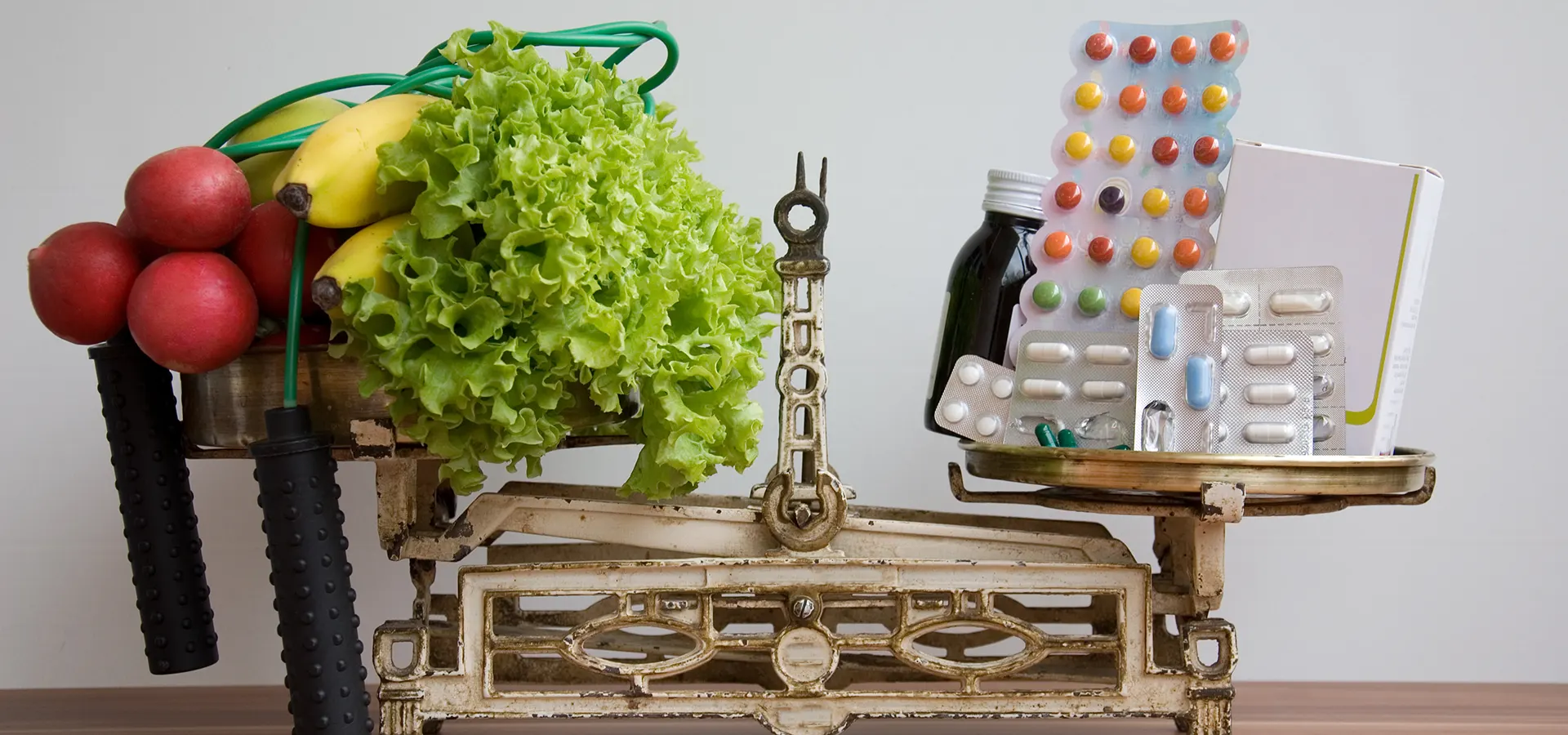THE BURDEN OF CHRONIC DISEASE
The United States is facing a growing healthcare crisis, driven by a tsunami wave of chronic disease. These non-communicable, often long-term illnesses feature our leading killers –heart disease and cancer– but also include type 2 diabetes, stroke, Alzheimer’s, kidney and lung disease. According to the Centers for Disease Control and Prevention (CDC), six out of ten adults in the U.S. have at least one chronic disease and four in ten have TWO or more. Collectively, non-communicable chronic diseases (NCDs) are responsible for seven out of every ten deaths in America, which translates to approximately two million lives lost every year.
NCDs account for a staggering 75-90% of healthcare spending in the country, which in 2021 amounted to 4.1 trillion dollars. This financial strain extends beyond healthcare costs, impacting not only productivity, but also quality of life, mental health and overall societal well-being. These jaw-dropping statistics are especially frustrating when you consider that about 80% of all chronic disease is preventable with healthier lifestyle choices and better use of our forks, feet and fingers.
What we put into our bodies using our forks is arguably the most important factor since we are what we eat, quite literally. Digging our own graves with utensils seems like a foolish endeavor by anyone’s standards. The importance of physical movement, putting fresh air in our lungs and enjoying positive social connections cannot be understated either. The more we use our feet to get us outdoors and going places, the better we will feel, both physically and mentally. And consciously preventing our fingers from putting tobacco, alcohol and narcotics into our system will also have the desired positive outcomes.
Yet, despite the potential for substantial savings in both lives and healthcare costs, the ‘sickness industry’ in the U.S. is plagued by a tangled interplay of interests that consistently prioritize treatment over prevention. There are very compelling reasons why you are bombarded with an endless array of drug commercials on news stations and nary an ad for broccoli or blueberries.
PROFITS OVER PUBLIC HEALTH
The American healthcare system is overwhelmingly profit-driven, with pharmaceutical companies, medical device manufacturers, and healthcare providers generating substantial revenue from the treatment of chronic diseases. Our reimbursement structure is largely fee-for-service, which means that providers are compensated based on the volume and complexity of the services they deliver. This business model often favors ongoing treatments over preventive measures, which in turn creates a disincentive for prioritizing prevention.
Medications and medical interventions, such as surgeries and therapies, also contribute significantly to industry profits, as does the lucrative market for medical devices like insulin pumps and continuous glucose monitors for long-term diabetes management. Dialysis centers for the treatment of chronic kidney disease (often associated with diabetes) are becoming so prevalent that California Bill AB 290 was signed into law in 2019 to prevent companies from monopolizing the industry and “gaming the system by increasing their already excessive corporate profits through a scheme to bankroll patients’ healthcare premiums,” said the legislator who introduced the bill.
And while we’re on the topic of diabetes, it’s worth noting that according to the Harvard T.H. Chan School of Public Health, 90% of type 2 diabetes cases can also be avoided by improving our diets and lifestyle habits. Maintaining the status quo of our Standard American Diet will mean that one out of three children born after the year 2000 are on target to become diabetic. If they are Hispanic or African American, those odds jump to one out of two. This is both unacceptable and heartbreaking. The crux of this predicament is that what sounds simple, is unfortunately not always easy. And therein lies our challenge if we want to turn the profit paradox of our healthcare industry on its head.
THE PATH FORWARD
The healthcare system’s modus operandi of prescribing a pill for every ill –while ignoring or failing to address the root case of what is creating all this illness– is akin to calling a plumber for a broken pipe and having them hand you a mop with which to sop up the water instead of fixing the leak. This situation becomes even more untenable when you realize you will also be paying for all the subsequent visits required when the mop fails to solve the problem.
Wendell Berry, author, environmentalist and cultural critic, accurately noted that “People are fed by the food industry, which pays no attention to health, and are treated by the health industry, which pays no attention to food.” We should have ads touting the anti-inflammatory benefits of fruits and vegetables; the nutrient and fiber dense properties of legumes, nuts and seeds; and the dangers of consuming wayward amounts of cancer-causing processed meats. What we see instead are a plethora of clickbait news headers about miracle weight loss drugs that cost thousands of dollars every month and cover stories hinting that it’s ok to eat all the butter and steak your heart desires. One could argue that the profit paradox of healthcare exists because the bill for a quadruple bypass surgery is bigger than it is for a bag of beans, and chemotherapy is a lot more expensive than chia seeds.
I’ve written in previous articles that no one goes to bed healthy and simply wakes up with Alzheimer’s or cancer. Chronic diseases take time to grow and fester and what we are failing to recognize at a national, if not global scale, is that the food we are eating today is what’s fueling the diabetes and heart disease we get years from now. That’s the hard part about prevention: it requires long-term resolve and commitment and we currently live in a culture that thrives on instant gratification. But if given the chance to go back in time and pass on all those double bacon cheeseburgers so that you don’t have to endure the pain and discomfort of end stage renal failure, amputations from diabetic neuropathy or losing your eyesight, most of us would undoubtedly take it.
We need a value-based model that will reward healthcare providers for reducing the incidence of chronic diseases, not just treating them. Somewhere, somehow, we must find the means to invest in public health campaigns that promote wellness-based behaviors and a culture of prevention. Increasing awareness via educational programs in schools, businesses and community centers on the harmful effects of highly-processed foods and added sugars, obesity, smoking, and drug and alcohol use, can also help encourage participation in making healthier choices and put a spotlight on the dangerous consequences of failing to do so.
The beginning of a new year is always a good time to reflect on the adjustments we can make to improve our quality of life. I suggest we band together and make 2024 a year of influencing positive change. Pledge with your family or friends to eat more plants, exercise more, or take up a new outdoor hobby. Involving others in your quest not only ups the accountability, it increases the ripple effect and your odds of success. By turning the healthcare paradox of prioritizing treatment and profits over prevention and public health upside down, we not only have the potential to save millions of lives, we go a long way towards guaranteeing our children a healthier and happier future as well.
####
Cindi is President and Founder of The Noble Path Foundation, a 501(c)(3) located in San Clemente, CA, dedicated to helping the youth of our communities reach their highest potential via healthy nutrition and lifestyle choices, safe and fun social activities, and motivational mentoring. For sources and links to the statistics mentioned in this article, please visit our website and search for the article under our blog at www.thenoblepathfoundation.org.
SOURCES:
Chronic Diseases in America: https://www.cdc.gov/chronicdisease/resources/infographic/chronic-diseases.htm
Health and Economic Costs of Chronic Diseases: https://www.cdc.gov/chronicdisease/about/costs/index.htm
Top 10 Most Expensive Chronic Diseases for Healthcare Payers:
https://healthpayerintelligence.com/news/top-10-most-expensive-chronic-diseases-for-healthcare-payers
The Growing Crisis of Chronic Disease in the United States:
https://www.fightchronicdisease.org/sites/default/files/docs/GrowingCrisisofChronicDiseaseintheUSfactsheet_81009.pdf
AN EPIDEMIC OF CHRONIC ILLNESS IS KILLING US TOO SOON:
https://www.washingtonpost.com/health/interactive/2023/american-life-expectancy-dropping/
Kidney Dialysis Is a Booming Business—Is It Also a Rigged One?:
https://www.scientificamerican.com/article/kidney-dialysis-is-a-booming-business-is-it-also-a-rigged-one1/
An Empirical Study of Chronic Diseases in the United States: A Visual Analytics Approach to Public Health:
https://www.ncbi.nlm.nih.gov/pmc/articles/PMC5876976/#:~:text=Additional%20statistics%20are%20quite%20stark,to
ward%20chronic%20diseases%20%5B5%5D.
Healthcare Reimbursement Still Largely Fee-for-Service Driven:
https://revcycleintelligence.com/news/healthcare-reimbursement-still-largely-fee-for-service-driven
Why Your Health Insurer Doesn’t Care About Your Big Bills:
https://www.npr.org/sections/health-shots/2018/05/25/613685732/why-your-health-insurer-doesnt-care-about-your-big-bills


